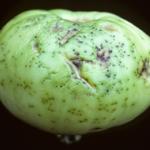Tomato, Bacterial Speck
Pseudomonas syringae pv. tomato
Bacterial speck on tomato, caused by Pseudomonas syringae pv. tomato, is a cosmopolitan disease, generally of minor concern, favored by low temperatures and high moisture.
Identification:
Pseudomonas syringae pv. tomato causes a fruit spot and foliage blight. Lesions on leaves are round and dark brown to black with a halo that develops with time. Spots may coalesce, killing large areas of tissue. On fruit, small (1/16 inch), dark spots or specks develop with the tissue around them often more intensely green than unaffected areas.
Life Cycle:
The bacterium is able to survive on tomato volunteers, may persist in weed species, and can overwinter in diseased plant debris. Seed is an important mechanism for survival and dissemination. The bacterium is spread in fields by wind-driven rain, workers, farm machinery, and aerosols. It penetrates through stomates and wounds created by insects, wind-driven sand, and tools.
Cultural Controls & Prevention:
- Buy certified seed from a reputable source or use seed treatments to reduce transmission.
- Produce disease-free transplants by raising transplants in an area where production does not occur. Inspect all purchased transplants carefully and if transplants originate in southern states they should be certified.
- Rotate fields to avoid carry-over on volunteers or crop residue.
- Keep fields free from volunteers, weeds, and cull piles.
- Avoid working in fields when bacterial diseases are present and the fields are wet.
- Apply appropriate bactericides or combination pesticides.
- In general, bacterial diseases of field crops are difficult to control with pesticides; copper/mancozeb solutions are most effective. When a significant amount of disease is present, pesticides are usually not effective.
Chemical Controls & Pesticides:
For Current information on disease recommendations ins specific crops including information on chemical control & pesticide management, please visit the New England Vegetable Management Guide website.
Crops that are affected by this disease:
The Center for Agriculture, Food and the Environment and UMass Extension are equal opportunity providers and employers, United States Department of Agriculture cooperating. Contact your local Extension office for information on disability accommodations. Contact the State Center Director’s Office if you have concerns related to discrimination, 413-545-4800 or see ag.umass.edu/civil-rights-information.
